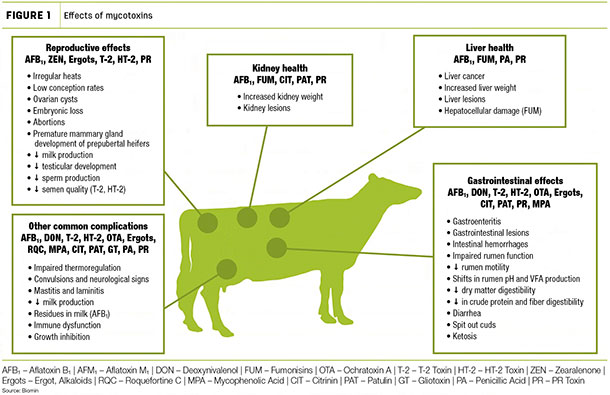Advances in knowledge and science have contributed to building tools in diagnostics, prevention and treatments that improve our ability to face such challenges. The issue of mycotoxins has been a story that took longer to be understood since advanced chemistry techniques were required to detect these toxic chemicals produced by certain fungi.
The effects of mycotoxins and their role in human illness and death were recorded in biblical times. Consumption of ergot-contaminated small grains including rye led to terrible pain, convulsions, hallucinations and gangrene in limbs. Scientific understanding has greatly reduced incidences of ergot toxicity in humans, but ergot alkaloids still pose a risk to animals in contaminated feed, and in the seed or even leaves of some grasses.
There are now over 400 mycotoxins identified, and more is being uncovered about the health challenges and loss of productivity they pose in livestock.
Mycotoxins can cause a variety of negative effects, including damage to the liver, kidneys and digestive tract. Many mycotoxins also cause immune dysfunction, resulting in an increased risk of disease. Multiple factors influence how animals are affected, including the specific mycotoxin, level and duration of exposure, animal species, age and animal health status as well as environmental factors.
Much research has focused on mycotoxins in grains, as they are sources of food for humans and are main ingredients in feed for monogastric species, including poultry and swine. However, mycotoxicoses (diseases caused by mycotoxins) occur frequently in ruminants, and this is often traced back to contamination in forages. The complex nature of ruminant diets leads to potential exposure to a broad spectrum of mycotoxins.

One of the best-known, forage-related mycotoxin challenges is in endophyte-infected tall fescue. Tall fescue is a hardy cool-season perennial grass estimated to cover more than 35 million acres of U.S. pastureland. Although tall fescue has benefits including good yields, drought tolerance and pest resistance, there can be drawbacks.
Toxicity issues often arise in tall fescue because it has a fungus living within the plant tissue referred to as an endophyte (“endo” = within, “phyte” = plant). This fungus provides beneficial characteristics to the plant, but naturally occurring wild-type strains of the fungus also produce ergot alkaloids, including ergovaline, which are toxic to animals.
Ergovaline reduces blood flow by narrowing blood vessels. This can lead to reduced feed intake, decreased bodyweight gain, elevated body temperature and respiration rates, reduced milk yield, rough hair coat, fescue foot (gangrene of the extremities) and bovine fat necrosis (masses of hard fat in the abdominal cavity causing digestive or calving issues).
Reproduction challenges can also occur, including abortions, prolonged pregnancy and calving issues. Many research projects have been dedicated to identifying management practices to reduce production losses and health challenges. Despite these advances, many producers are still faced with challenges from tall fescue.
Additional well-known mycotoxin challenges in pasture grasses include perennial ryegrass staggers and paspalum staggers.
These neurologic conditions are also linked to alkaloid toxins produced by endophytes. While death is uncommon, it can occur in severe cases or if the source of contamination is not removed. Handling of affected animals can worsen the staggers, so care is necessary when moving affected animals.
Mycotoxin challenges arising from fusarium species of molds have been reported in pasture grasses in New Zealand since studies began in the 1970s. This includes identification of zearalenone (ZEN), a reproductive toxin, in pastures where livestock exhibited poor reproductive performance despite good management and adequate nutrition.
Isolation of fusarium molds, as well as a mix of mycotoxins from pasture grasses, have originated from additional countries, including South Africa and Argentina.
Livestock producers around the U.S. deal with many challenges including heat stress and pest pressure. This is especially true across the Southern regions. Another potential factor limiting animal health and performance may be mycotoxin contamination in pasture grasses.
Grazing animals are often thought to be at low risk for mycotoxin exposure, as they tend to consume relatively limited amounts of grains. However, a mycotoxin survey of Southern U.S. pastures has identified the potential for high levels of contamination in several grasses.
A variety of mycotoxins have been detected, including high levels of ZEN, type A trichothecenes (T-2 toxin and HT-2 toxin), and type B trichothecenes that include deoxynivalenol (DON aka “vomitoxin”), nivalenol (NIV) and fusarenon X (FusX).
The pasture grass survey began in March 2016 with the majority of samples originating from Florida pastures. Initial sampling identified the potential for high levels of ZEN in bermudagrass. To date, nearly 400 pasture samples have been screened for up to 17 mycotoxin metabolites at one of two analytical laboratories (Romer Labs, Union, Missouri, and ActLabs, Ancaster, Ontario, Canada).
The majority (84.7 percent) of samples were bermudagrass. The results are concerning. In bermudagrass samples, over two-thirds (68 percent) tested positive for some level of ZEN (average 1,718 parts per billion [ppb] on a dry matter basis) and around 19 percent tested positive for type A trichothecenes (average 1,226 ppb).
Observed contamination varied over time, with the highest mycotoxin levels detected during the winter months and early spring. High variability has also been seen between pastures, with some pastures not having any mycotoxins detected and others with very high levels occurring.
Reproductive challenges including low conception rates and abortions, lower body condition score in dams, reduced calf crop and decreased calf-weaning weights have been reported in pastures with contamination.
The survey is an ongoing effort designed to increase the understanding of mycotoxin occurrence in pasture grasses. Additional grass species are being sampled, and the geographic area has expanded to include additional states to determine how extensive this issue is.
Based on results of the three-year survey, mycotoxin contamination in pasture grasses has been both frequent and at high enough levels to warrant consideration of mycotoxins as an influential factor in the reproductive success, health and performance of grazing cattle. ![]()

-
Paige Gott
- Ruminant Technical Manager
- Biomin America Inc.
- Email Paige Gott






